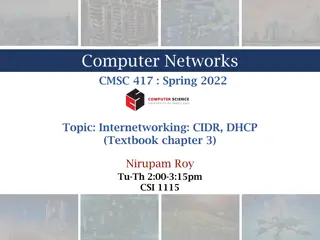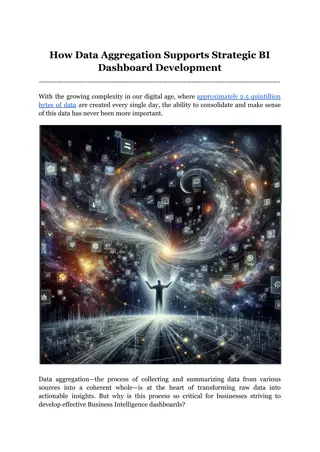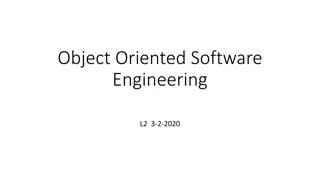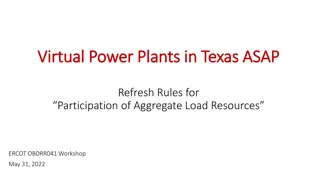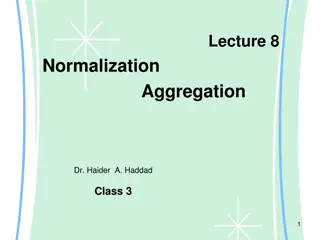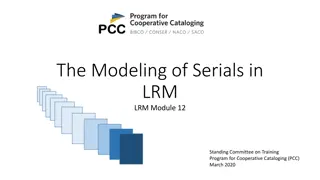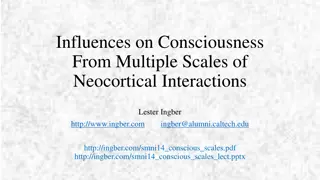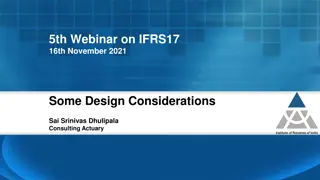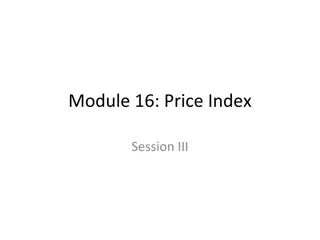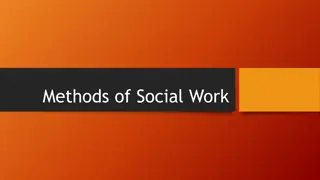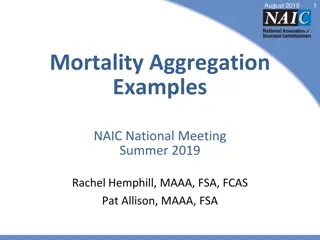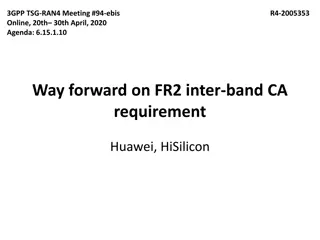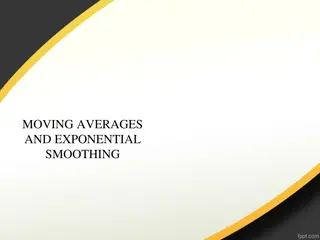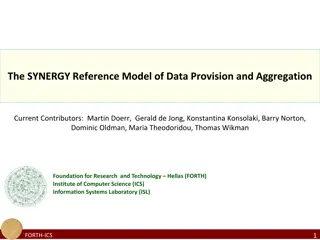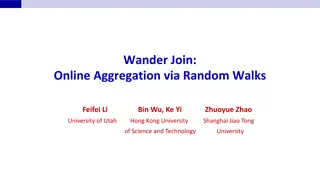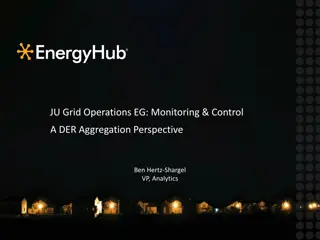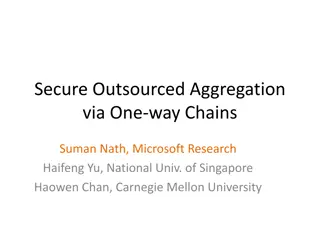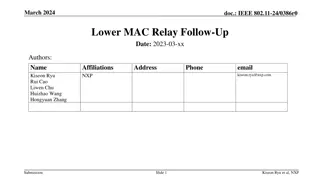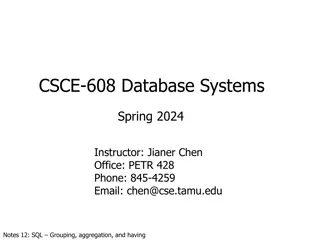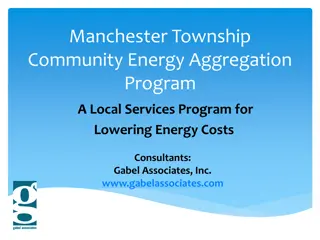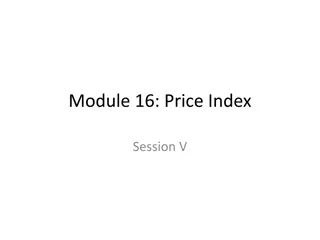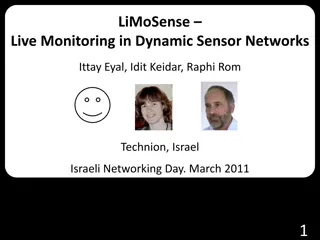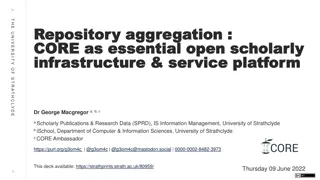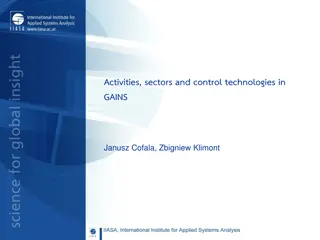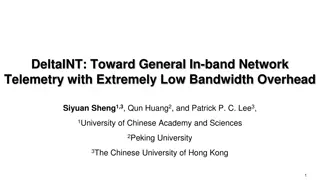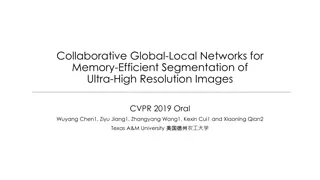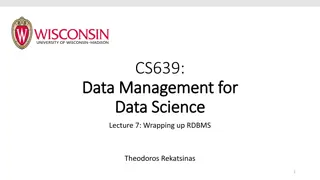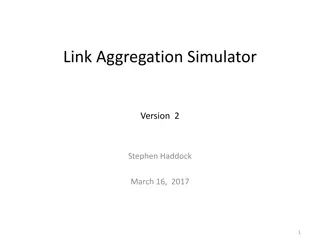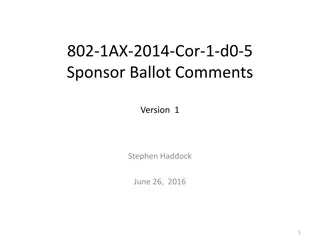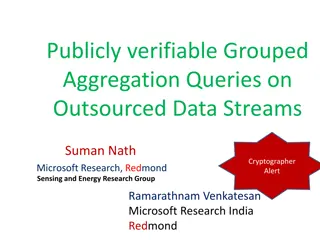FOLIO & Linked Data Functionality Review
Listening to the needs of libraries worldwide, the collaboration between Library of Congress, FOLIO, and EBSCO aims to improve data flow and accessibility through Linked Data aggregation. The initiative includes making BIBFRAME adoption easier, enhancing BIBFRAME editing functionality, and automatin
2 views • 12 slides
Semi-Supervised Credit Card Fraud Detection via Attribute-Driven Graph Representation
Explore a novel approach for detecting credit card fraud using a semi-supervised attribute-driven graph representation. The technique leverages temporal aggregation and attention layers to automatically unify heterogeneous categorical attributes and detect fraudulent transactions without label leaka
1 views • 23 slides
Computer Networks CMSC 417 : Spring 2022
Exploring the concepts of Classless Interdomain Routing (CIDR) and Dynamic Host Configuration Protocol (DHCP) in the context of internetworking. CIDR simplifies subnetting by allowing for classless addressing, hiding network hierarchies, and enabling supernetting. Lessons learned from subnetting inc
0 views • 57 slides
Oklahoma Transportation GIS Cabinet Overview
Oklahoma's Transportation Cabinet consists of three agencies responsible for managing federal aid highways, county roadway data aggregation, Turnpike infrastructure, and aeronautics. The GIS infrastructure includes 18 full-time staff primarily using Esri Enterprise GIS tools for data integration and
1 views • 10 slides
How Data Aggregation Supports Strategic BI Dashboard Development
This explores how combining data from different sources into a clear and organized format is key to making an effective Business Intelligence dashboard.
3 views • 6 slides
Understanding Object-Oriented Software Engineering Principles
Explore the concepts of inheritance, generalization/specialization, UML representation, object/class relationships, multiplicity notations, and aggregation in object-oriented software engineering. Learn how methods and attributes can be inherited, grouped, and reused among classes, and understand th
0 views • 30 slides
Maximizing Distributed Energy Resources Through Virtual Power Plants in Texas
Texas is exploring the deployment of Virtual Power Plants to enable customers with Distributed Energy Resources (DERs) to participate in providing dispatchable Megawatts and Ancillary Services. The state recognizes the potential of DERs, with projections indicating a significant capacity increase in
0 views • 24 slides
Exploring Supramolecular Chemistry: Insights and Applications
Supramolecular chemistry delves into the chemistry of molecular assemblies, intermolecular bonds, and non-covalent interactions, leading to the formation of supra-molecules through aggregation of molecular subunits. Concepts like molecular recognition, self-organization, and host-guest chemistry pla
0 views • 18 slides
Database Normalization and Aggregation Concepts
Understanding the advantages and disadvantages of database normalization, the concept of aggregation in the ER model, and examples of creating ER diagrams using aggregation rules with related entities. Explore the benefits of smaller databases and better performance through normalization, and how ag
4 views • 11 slides
Modeling of Serials in IFLA LRM Module 12 by PCC
Serials in library cataloging are modeled as complex constructs in IFLA LRM with considerations for whole/part and aggregation relationships. This module explores the intricacies of serial manifestations, issue manifestations, and the concept of WEM lock, providing insights into collocating closely-
0 views • 15 slides
Exploring Influences on Consciousness Through Neocortical Interactions
Delve into the intriguing realm of consciousness with Lester Ingber's research on the influences stemming from multiple scales of neocortical interactions. The investigations cover various aspects such as mind over matter, recursive interactions, neuronal scales in the neocortex, and statistical mec
1 views • 41 slides
Understanding IFRS 17 Implementation: Key Design Considerations
Implementation of IFRS 17 requires a structured approach in the design phase to avoid disruptions to business operations and financial systems. This article emphasizes the importance of proper planning, assessment, and execution to ensure a smooth transition. Key topics include level of aggregation,
0 views • 28 slides
Understanding Colloids and Their Importance in Pharmaceuticals
Colloids play a vital role in the pharmaceutical industry as heterogeneous biphasic systems with particle sizes ranging from 1nm to 100nm. They are classified based on aggregation and interaction of phases, with examples like aerosols, foams, emulsions, and more. Colloids can be prepared by condensa
0 views • 23 slides
Implications of Large-size RU Aggregation on RTS/CTS in IEEE 802.11-17
Addressing implications of large-size RU aggregation on RTS/CTS in IEEE 802.11-17, focusing on the signaling of Enhanced High Throughput Format PPDU Bandwidth and puncturing in RTS/CTS frames. Proposing the use of HE MU-RTS Trigger frame to elicit CTS response from STAs, along with different CTS for
4 views • 17 slides
Understanding Price Index Formulas and Aggregation Methods
Exploring the significance of price index formulas and aggregation methods in economic analysis. Learn about simple and weighted aggregate indices, elementary index calculations, and why aggregation methods are essential for computing price changes accurately.
0 views • 30 slides
Privacy-Preserving Prediction and Learning in Machine Learning Research
Explore the concepts of privacy-preserving prediction and learning in machine learning research, including differential privacy, trade-offs, prediction APIs, membership inference attacks, label aggregation, classification via aggregation, and prediction stability. The content delves into the challen
0 views • 11 slides
Understanding Methods of Social Work
Methods of social work encompass various approaches aimed at enhancing social functioning and addressing problems in individuals and communities. These methods are categorized into primary and secondary methods, each serving different purposes in the field. Primary methods involve direct interaction
0 views • 20 slides
Mortality Aggregation Examples at NAIC National Meeting
In August 2019, key concepts for mortality aggregation were discussed at the NAIC National Meeting. The examples presented covered approaches under VM-20 language, emphasizing the importance of informed mortality segment assumptions through credible aggregation methods.
0 views • 21 slides
Agreements on FR2 Inter-Band Carrier Aggregation Requirements
Agreements have been reached on the RRM requirements and scaling factors for FR2 inter-band Carrier Aggregation, focusing on common beam and independent beam management. Discussions include alignment with Release 16 specifications, scenarios, and RF architectures. Interruption requirements for diffe
0 views • 8 slides
Understanding Moving Averages and Exponential Smoothing Methods
Forecasting methods like moving averages and exponential smoothing are essential for analyzing time series data. Averaging methods involve equally weighted observations, while exponential smoothing methods assign unequal weights that decay exponentially. Both methods can be useful for forecasting in
0 views • 18 slides
SYNERGY Reference Model for Data Provision and Aggregation
The SYNERGY Reference Model, developed by a team of respected contributors, outlines strategies for effective data provision and aggregation. Led by renowned experts from FORTH, the model offers valuable insights for enhancing research practices and data management processes.
0 views • 81 slides
Wander Join: Online Aggregation via Random Walks in Database Workloads
Wander Join is a technique for online aggregation using random walks, addressing challenges in efficiency and correctness in both transactional and analytical database workloads. It allows for complex analytical queries such as TPC-H queries and provides insights into revenue loss due to returned or
0 views • 27 slides
DER Aggregation in Monitoring and Control Operations
In the realm of energy grid operations, DER aggregation plays a crucial role from both short and long-term perspectives, focusing on transactive energy and autonomous devices. Communication and coordination are key for successful monitoring and control, with a need for a common framework supporting
0 views • 12 slides
Secure Outsourced Aggregation via One-way Chains - Research Overview
Exploring secure outsourced aggregation techniques using one-way chains for wide-area shared sensing and weather monitoring. The unique characteristics, challenges, and solutions for dealing with malicious aggregators are discussed. The research presents the contributions and advancements in optimiz
0 views • 30 slides
IEEE 802.11-24/0386r0 Lower MAC Relay Protocol Details
Detailed discussion on supporting the relay protocol in IEEE 802.11bn, covering relay addressing, end-to-end BA, relay TXOP protection, beacon forwarding, security processing, non-UHR STA support, sounding procedure, A-MPDU aggregation, de-aggregation, and more. The relay operation involves relay de
0 views • 16 slides
Understanding SQL Aggregation and Grouping in Database Systems
SQL offers powerful aggregation functions like SUM, AVG, COUNT, MIN, and MAX to perform calculations on column data efficiently. By utilizing DISTINCT and GROUP BY clauses, you can manipulate and organize your data effectively in database systems while handling NULL values appropriately.
0 views • 54 slides
Understanding the Difference Between Aggregation and Composition in Object-Oriented Programming
Aggregation and Composition are two important concepts in object-oriented programming. Aggregation refers to a 'has-a' relationship where the contained object can survive independently, while Composition indicates that the member object is part of the containing class and cannot exist separately. Th
0 views • 15 slides
Manchester Township Community Energy Aggregation Program Overview
The Manchester Township Community Energy Aggregation Program, implemented under GEA and BPU rules, allows residents to pool together for better energy prices. The program involves a competitive bid process, with the contract awarded to TriEagle Energy. Residents benefit from reduced energy costs, co
0 views • 14 slides
3GPP TSG-RAN4 Meeting #97e Summary
During the 3GPP TSG-RAN4 Meeting #97e, discussions on Multi-RAT Dual Connectivity and Carrier Aggregation enhancements were held. A Work Item (WF) focusing on Idle mode Carrier Aggregation (CA) measurement Radio Resource Management (RRM) requirements was addressed. The meeting included topics such a
0 views • 17 slides
Constructing Price Index: General Procedure and Aggregation
The process of constructing a price index involves various steps such as computation of price relatives, aggregation at different levels, selection of base period, and designing data collection methods. Weighted arithmetic mean and simple ratio calculations are used in aggregating price indices. A t
0 views • 31 slides
Real-time Monitoring in Dynamic Sensor Networks: LiMoSense Study
This study delves into LiMoSense, a live monitoring approach for dynamic sensor networks, exploring challenges such as correctness, convergence, and dynamic behavior. The research focuses on sensors' communication, aggregation of read values, and the use of bidirectional and unidirectional communica
0 views • 45 slides
IEEE 802.11-19/0773r0 Multi-link Operation Framework Summary
The document discusses the multi-link operation framework for IEEE 802.11-19/0773r0, focusing on load balancing and aggregation use cases. It introduces terminology related to multi-link logical entities and provides examples of multi-link AP and non-AP logical entities. The framework considers stee
0 views • 16 slides
Advancing Scholarly Research Through Data Aggregation and Infrastructure Services
Enabling the creation of new scientific knowledge and discoveries, data aggregation platforms like CORE play a pivotal role in connecting repositories and facilitating structured data harvesting. These platforms contribute to the knowledge graph, support text and data mining, and offer valuable serv
0 views • 7 slides
Activities, Sectors, and Control Technologies in GAINS Research
The GAINS research by Janusz Cofala and Zbigniew Klimont focuses on aggregation criteria for emission sources, macroeconomic parameters such as population and GDP, aggregation of energy-related sources, transport sources, and process sources. It also covers specific VOC processes/sources like solven
0 views • 13 slides
DeltaINT: General In-band Network Telemetry with Low Bandwidth Overhead
This paper discusses DeltaINT, a novel framework for in-band network telemetry aimed at reducing bandwidth overhead while ensuring high generality and convergence. It addresses the limitations of existing methods by providing theoretical analysis on bandwidth mitigation guarantees and offering softw
0 views • 20 slides
Collaborative Global-Local Networks for Memory-Efficient Segmentation of Ultra-High Resolution Images
This research project presented at CVPR 2019 by Wuyang Chen, Ziyu Jiang, Zhangyang Wang, Kexin Cui, and Xiaoning Qian focuses on memory-efficient segmentation of ultra-high resolution images using Collaborative Global-Local Networks. The study explores the benefits of employing two branches for deep
0 views • 12 slides
SQL Aggregation and Group By: Understanding Concepts and Examples
Exploring SQL aggregation operations such as AVG, COUNT, and more, along with the GROUP BY clause for grouping data based on specific attributes. Examples illustrate how to use these features effectively in SQL queries to retrieve meaningful insights from databases.
0 views • 44 slides
Overview of Link Aggregation Simulator
This presentation provides an overview of a Link Aggregation Simulator designed to demonstrate and test LACP and DRCP operation. It guides users through creating devices, adding components, including link aggregation, and scheduling events. The simulator allows for testing of network components and
0 views • 20 slides
Distribution Algorithms in Link Aggregation Groups
In the context of IEEE 802.1ax standard, the distribution algorithms for Link Aggregation Control Protocol (LACP) are explained. The standard allows for flexibility in choosing distribution algorithms, with version 2 enabling explicit coordination. The problem of per-Aggregator distribution algorith
0 views • 15 slides
Publicly Verifiable Grouped Aggregation Queries on Outsourced Data Streams
Explore the challenges and solutions for publicly verifiable grouped aggregation queries on outsourced data streams, focusing on security, verification, and cloud computing. The research discusses how to handle large amounts of data using small memory components and emphasizes the importance of data
0 views • 34 slides


